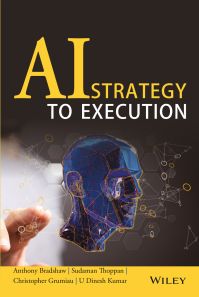AI Strategy to Execution
ISBN: 9789357469975
356 pages
For more information write to us at: acadmktg@wiley.com

Description
In this book, we discuss the “strategy to the execution gap” a leader of an organization encounters while adopting Artificial Intelligence (AI) in that organization. The main focus is on value creation using AI and use of AI as competitive strategy. Although every organization across various industries is interested in integrating Artificial Intelligence into their business, a significant dilemma is the right AI strategy for their organization.
Preface
About the Authors
Acknowledgement
Chapter 1 Strategy to Execution Gap
1.1 Introduction
1.2 Business Strategy for AI and An Execution Plan – Why?
1.3 AI Business Strategies
1.4 Strategy to Execution Gap
1.5 Preparing Organizations for AI Journey
1.6 Journey Towards a “Data-Driven” Company
1.7 Transformation and Change Management
1.8 Contexts Explained by Historical Facts and Reasons to Become Data-Driven
1.9 Challenges
Chapter 2 Analytics Landscape
2.1 Introduction
2.2 Data and Analytics in a Nutshell
2.2.1 Artificial Intelligence (AI)
2.2.2 Machine Learning (ML)
2.2.3 From Statistics to Statistical Learning (SL)
2.2.4 Statistical Learning (SL)
2.2.5 Deep Learning (DL)
2.3 AI As Competitive Strategy
Chapter 3 School of Outputs and Outcomes
3.1 Introduction
3.2 Outputs, Outcome, and Operationalization: An Introduction
3.3 AI as an Enabler of Outcome
3.4 AI Operationalization
3.5 Roles and Responsibilities of Personnel and Technology in AI Operationalization
3.6 Operationalization via the Circle of Influence
3.7 AI Readiness Framework and Adoption Model
3.8 Outcome Calculation
3.9 Governance Principles for Outcome Realization
3.10 Outcome Measures
3.11 Data and Analytics-Specific Adoption Rate
Chapter 4 Data Culture and Change Management
4.1 Introduction
4.2 Need for Data-Driven Culture
4.3 Strong Organizational Change Management – Basis for AI Success
4.4 Change Management – Literature View
4.5 Change Management in Practice
4.6 Data-Driven Decision-Making (3DM) Execution Strategy
4.7 Culture Change from People and Project Perspectives
Chapter 5 The School of Expertise, Innovation, and Organizational Intelligence
5.1 Introduction
5.2 Expertise, Dynamic Capabilities, and Organizational Intelligence
5.3 Expertise Linked to Innovation
5.4 Strategic Workforce for AI Initiatives – Headhunting, Hiring, Onboarding, Chapter Lead, and HR Coach
5.5 School of Expertise and Chapters within AI Journey Initiative
5.6 Collaboration with Educational Institutes/Innovative Stakeholders
5.7 Expertise versus Innovation?
Chapter 6 The School of Execution
6.1 Introduction
6.2 The Silo Effect
6.3 The Golden Rules to Become Hyper-Relevant
6.4 Data Product Management/Leadership
6.5 Ways of Working
Chapter 7 Data Value Management
7.1 Introduction to Data Value Management
7.2 Data Governance
7.2.1 Data Governance: Implementation
7.3 Governance per Design
7.4 Data Architecture
7.5 Data Quality
7.6 Master Data
7.7 Metadata Management
7.8 Data Gathering Process and Warehousing
7.9 Data Governance Success Stories
7.10 Data Value Management – End-to-End Implementation
Chapter 8 Strategy for Data and Analytics
8.1 Strategy for Data and Analytics
8.2 Data Strategy and Analytics Strategy
8.3 Data and Analytics Setup
8.4 Framework to Support the Organization
8.5 The Federated Center of Competence
8.6 The CRISP-DM Model
8.7 Audit and Maintenance
8.8 MLOps via CI-CD Development
Chapter 9 Ethics and Privacy by Design
9.1 Introduction
9.2 Regulation
9.3 Fairness – Anti-Discrimination
9.3.1 Data Bias
9.3.2 Indirect Bias
9.3.3 Model Bias
9.4 Human Control and Interpretation
9.5 Unethical Use of AI
9.6 Enterprise Readiness to Manage AI-Related Risks
Chapter 10 Strategy to Execution (S2E) Framework
10.1 Introduction
10.2 Strategy and Execution Link
10.3 Strategy Block
10.4 Bridge to Execution Block
10.5 Execution Block
Chapter 11 Data Inspired Organization Management Technologies
11.1 Introduction
11.2 Strategic Workforce Management with DAFL (Data As Future Language)
11.3 Data As Future Language (DAFL) – in Reality
11.4 DAFL Seen As a Company Asset for Strategic Workforce Creation
Chapter 12 Data Storytelling
12.1 Introduction
12.2 History of Storytelling
12.3 Why Storytelling Matters?
12.4 Importance of Business Storytelling
12.5 The Columbia Story
12.6 Storytelling Frameworks
12.7 Data Storytelling
Summary
References
Index

